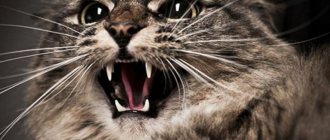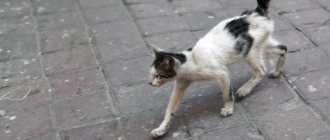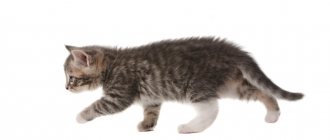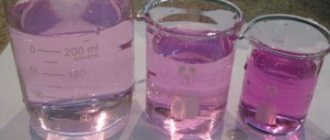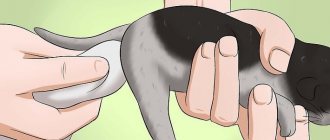Odor storage
And again we return to plastic bags. They are made from a polymer material, the gaseous hydrocarbon ethylene. These bags have the amazing property of absorbing all odors (especially the odors of the contents). For example, you buy food in a supermarket - fish, chicken, meat, etc. All this is wrapped in polyethylene. At the checkout, purchases are packaged in another, “large” branded bag. As you know, cats have a sensitive sense of smell. All the plastic packaging containers managed to become thoroughly saturated with food on the way home from the store. The logical result is the purr’s increased interest in the packages you brought.
Why do cats like bags?
Cats lick plastic bags for a number of reasons.:
- The simplest option is that a plastic bag retains the smell of the product that was wrapped in it. In the case of meat and dairy products, the increased interest in used packaging on the part of curious pets is easily explained.
- Your cat may have tooth or oral pain. By chewing a soft bag, the pet tries to relieve discomfort.
- Biodegradable bags are made on the basis of starch; animals may be attracted by the smell, although it is imperceptible to humans.
- To prevent the bags from sticking together during storage and transportation, they are treated with so-called “sliding agents.” Typically, it is stearic acid, which is obtained from animal fat. In this case, a curious cat may be attracted by the smell of the bag.
- The structure of the bag is smooth and cool; in the warm season, the animal may simply enjoy lying on such a surface.
- The rustling sound can attract animals, especially kittens.
- Stress can cause your cat to become more interested in bags. If a pet is in an unfavorable environment and does not feel safe, then this may be the impetus for increased interest in cellophane.
- A cat or cat is trying to entertain itself. When a pet is alone for a significant part of the time or left to its own devices, the owners do not pay attention to it and do not play with it, then the animal very quickly finds a way to entertain itself.
© shutterstock
Thus, a plastic bag as a toy is not a signal of the onset of pathological processes in the animal’s body, but banal loneliness or curiosity. In rare cases, this may be due to health problems.
Pica - “perversion of taste”
Some cats (we emphasize that they are a minority) happily eat completely inedible things and objects, including plastic bags. The generally accepted term in world medicine for “perversion of taste” is called “pica”. Experts and scientists are divided on the nature of pica. Some experts believe that pica manifests itself solely due to malnutrition; cats lack certain vitamins, elements or minerals. Others believe that pica is simply a consequence of early weaning of kittens from the mother's breast. Time will tell who is right; serious research is still ahead.
How can I help you
If the animal feels normal, then help will not be needed. It is recommended to consult a doctor if your pet’s condition worsens. If a cat has eaten a plastic bag, only the veterinarian can decide what to do. The first step is diagnostics: ultrasound, x-ray or radiography with a contrast agent.
Options for the veterinarian:
- Prescribe a diet and supportive therapy if the piece of polyethylene does not cause obstruction in the cat or injure internal organs. The foreign object will come out on its own. Sometimes it is enough to carefully pull it out of the rectum.
- Carry out the operation. Indications: blockage of the intestines, stomach, lack of effect in the prescribed diet, tissue necrosis. During surgical interventions, anesthesia is used, which is dangerous for cats over 7 years old and in the presence of heart and kidney diseases.
It is forbidden to self-medicate, give oils, laxatives. Most often this ends with a deterioration in health, an urgent visit to the clinic, or surgery. Do not pull cellophane out of the anus and induce vomiting. A doctor's appointment is required if the kitten has swallowed the bag. You need to know not only what to do if a cat ate a bag, but also how to protect it: limit access, remove the trash bag out of reach.
How to wean a cat from a bad habit
Licking bags is far from a harmless activity for cats. During this process, the animal chews and swallows small pieces, which can lead to intestinal obstruction. You can prevent unpleasant developments in the following ways:
- limit access to cellophane: do not leave food in bags on the floor or table, close the trash can in the kitchen cabinet;
- Check the condition of your pet’s teeth and entire oral cavity with a veterinarian;
- buy toys so that the cat always has the opportunity to occupy himself;
- eliminate factors that cause stress in your cat;
- balance the animal’s nutrition, including all necessary vitamins and microelements in the diet;
- treat your pet with special chewing sticks with mint or matatabi.
What to do if your cat licks bags?
Many owners often encounter cats licking bags. Moreover, the animal can not only lick the cellophane, but also begin to tear it and try to chew it. This behavior of a pet can confuse owners, because cellophane is not a food product, its taste is probably inexpressive, and the content of nutrients is questionable. However, for an animal, packaging may be of interest for several reasons. They should be dealt with in order not only to get an answer to the question of what the animal needs, but also to wean it from such an unsafe habit.
Should I worry?
From time to time, cats may eat sausage rinds, Christmas tree decorations, or bags containing meat or fish products. If the piece of polyethylene is small, then there is nothing wrong with that. It leaves the body on day 3-4 along with feces, without causing significant harm to the animal. Under natural conditions, cats can eat non-food fibers, which they use to cleanse their stomachs, so it is not surprising that they chew rags, bags and inedible things. Veterinarians advise that if cats start eating bags, bring them grass that has not been treated with chemicals, soft chicken bones or special solid food for animals, which is best selected together with a veterinarian.
© shutterstock
Even if a cat, like a dog, eats a large inedible object, it will vomit it. It will not penetrate the intestines and will help the animal cleanse its stomach. It is worth observing the behavior of the animal for 3-4 days. If it hasn't changed, there's nothing to worry about. But if after consuming the package you notice the following symptoms, you should immediately contact the clinic, even if the cat ate a small piece of cellophane :
- restless meowing, excitement. The cat begins to fuss and bother the owners, which has not been observed before;
- constipation, the cat cannot go to the toilet;
- The belly is enlarged, but the cat won’t let me touch it. In some cases, the animal begins to constantly lick its belly or roll on the floor;
- persistent vomiting and lack of appetite;
- constant diarrhea;
- lethargy, apathy and refusal to eat.
Even if the cat ate a small piece, the symptoms described above may indicate intestinal obstruction or a foreign object in the body that requires urgent intervention from a specialist. If no measures are taken, the animal may die. Therefore, at home it is dangerous to give a cat a laxative or try to induce vomiting. A cat can eat a plastic bag along with its contents. In this situation, the likelihood of intestinal obstruction is reduced, but rough parts from the food bag can injure the intestines and cause alarming symptoms.
Consequences: is it dangerous?
Even if the pet swallowed a small piece of the bag, the symptoms described above indicate the occurrence of intestinal obstruction. If timely help is not provided, the problem can even lead to death.
The owner should not ignore the appearance of vomiting in the animal after the incident.
If a cat has eaten a piece of polyethylene, it is mostly eliminated from the body without outside help, but there are also situations when swallowing the bag causes complications. When the owner notices that a pet has consumed polyethylene, it is important to monitor its condition for several days. When no changes are observed in it, there is no reason to panic. However, if an animal has eaten a plastic bag and exhibits the following symptoms, it is important to contact a veterinarian as soon as possible:
- anxiety;
- constipation;
- increase in abdominal size;
- inappropriate behavior when trying to touch the peritoneum;
- loss of appetite;
- constant vomiting;
- diarrhea;
- weakness and apathy.
How to stop your cat from licking plastic bags.
Since many things can harm a cat's health, you need to ensure that she does not have access to them. This is especially important in the case of packages. Make sure there are no bags in areas where your cat can get to, including closets, trash cans, etc.
Providing your cat with opportunities for entertainment also plays an important role in weaning your cat off chewing on inappropriate objects. Animal behaviorists believe that cats need sensory information from all sources—smell, taste, touch, and sound. If your cat licks bags, buy toys from the pet store that have similar properties, such as crunchy balls. Choose objects that are different from each other so she can enjoy a wide range of textures and sounds while playing with them.
Set aside more time for playing with your cat to exercise it both physically and mentally, especially since you will also enjoy it. Use toys that require shared participation in play, such as a fishing rod. Interactive food toys that allow your cat to exercise his hunting instincts through play are also a good way to keep his mind occupied and his body exercised. Some cats may not mind learning simple tricks and commands - sit, lie down, etc. This is also a great way to increase exercise for your cat and give her the opportunity to have new experiences.
Why are cats attracted to plastic bags?
If there was something edible in the bags, its smell
or even
the taste
may last long enough to arouse the cat's interest, especially if she likes the food that was previously in the bag.
Some bags are also coated with substances such as cornstarch, stearates (salts of stearic acid), or made with animal by-products such as gelatin to make them attractive. Additionally, cats may enjoy the crunching sounds
that plastic bags make when they are licked.
Another reason that encourages a cat to lick or chew bags is related to the condition of the teeth. If you notice that your cat has started licking bags, you need to contact your veterinarian to make sure that her teeth are
in order. Your veterinarian may advise you to make some changes to your cat's diet, as chewing on non-edible items may be a symptom of a lack of essential nutrients in the daily diet.
How to wean an animal from playing with bags
If cats lick bags with enviable regularity, you can take the following steps::
- Carefully hide all cellophane packaging in places inaccessible to cats.
- If bags are used for the trash can, it should also be out of reach.
- If you suspect dental or oral disease, your cat should be taken to a veterinarian. The doctor will find out the cause of the disease, prescribe treatment, and the animal will stop showing interest in the unsafe toy.
- Buy your cat a special exercise machine with ropes, ladders and rest areas. Models of varying heights and complexity are available for sale to suit any budget. When the owners are not at home, the animal will not be bored, the cat will be able to occupy itself.
- Spend more time with your pet, petting it and playing with it. Always talk to a cat in a calm, even voice, even if the animal has harmed or damaged something.
- If a cat stole a bag somewhere and started playing with it, you should immediately take the dangerous toy away from him and offer him a ball or a fabric mouse in return.
